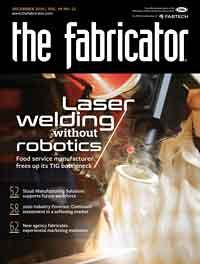Principal
- FMA
- The Fabricator
- FABTECH
- Canadian Metalworking
Categories
- Additive Manufacturing
- Aluminum Welding
- Arc Welding
- Assembly and Joining
- Automation and Robotics
- Bending and Forming
- Consumables
- Cutting and Weld Prep
- Electric Vehicles
- En Español
- Finishing
- Hydroforming
- Laser Cutting
- Laser Welding
- Machining
- Manufacturing Software
- Materials Handling
- Metals/Materials
- Oxyfuel Cutting
- Plasma Cutting
- Power Tools
- Punching and Other Holemaking
- Roll Forming
- Safety
- Sawing
- Shearing
- Shop Management
- Testing and Measuring
- Tube and Pipe Fabrication
- Tube and Pipe Production
- Waterjet Cutting
Industry Directory
Webcasts
Podcasts
FAB 40
Advertise
Subscribe
Account Login
Search
Lean manufacturing: It’s about the detail
Broad strategy takes a fabrication shop only so far in its lean journey
- By Jeff Sipes
- December 27, 2019
- Article
- Shop Management

Continuous improvement in lean manufacturing needs a broad strategy, but sometimes you need to observe the work, pay attention to details, and ask questions. Getty Images
Your lean journey is made up of many moving parts. Your people get educated, run kaizen events, use lots of different analysis tools, and develop lean strategies and plans. And you still run the business, satisfy customers, ship products, and collect cash.
It would be easy for you to get so caught up in all the activities that you lose sight of the details. Think of operational details as things that, if done well, do not get much attention. They are “satisfiers” that are simply expected. But if these operational details are not adequately attended to, they can quickly become “dissatisfiers” that raises justifiable question about the seriousness of your lean journey. In short, the lack of attention to the dissatisfiers undermines your credibility.
Examples of Operational Details
Consider the person who unloads the parts from the laser cutting operation. Let’s call him Sam. Look at operational details that affect how Sam does the job. If you think all Sam has to do is knock the laser-cut parts out of the skeletons, then you are not paying attention to operational details.
The flow of information and parts can affect the success of the “unload and move downstream” operation. Do the parts flow in and out of the work area smoothly, or do they move in fits and starts? Are they set in a staging area waiting for someone to finally do the paperwork, or get mixed up so that a re-sort has to occur before they can be moved to the next operation?
Is the laser cutting head properly aligned so that good, clean cuts are occurring, or are you getting excess slag, too much kerf angle, or ragged cuts because the laser head was knocked out of alignment? All of these problems result in downstream waste (have to grind the slag) or defects (part won’t fit in fixture due to kerf angle).
Finally, does Sam have to physically carry the parts he knocks out of the skeleton to the sorting skids or tables? If so, are they close by, or is Sam walking and carrying a longer distance than necessary (muda of motion and transportation)? Worse yet, is Sam bending over time after time to place the heavy parts on the skid sitting on the floor? If you are not raising the surface where Sam is placing the parts to an ergonomic height, you increase the chance for injuries. Sam might just accept that this is all part of the way the work is supposed to be done and keep going. Would you be willing to accept that this is just the way it is?
Consider Mary, a welder. What are some of the operational details that affect her job? By now in your lean journey you understand that standard work and standard processes are important tools in the lean toolbox. Part of the standard process should be having predetermined welding parameters (heats, feeds, speeds, etc.) so that variation is reduced or eliminated. Does Mary know what those parameters are, or does she set her own?
What about parts presentation in Mary’s weld cell? If parts are presented to her in a manner that fits with her process (right location on the floor, parts flipped correct side up, minimal motion required to retrieve parts for the next weld cycle, and no opportunity to mix similar-looking parts), then there is attention to operational detail.
These items focus on the parts being presented to Mary, but what about the assembled parts Mary is sending to the next operation? How should these assemblies be organized so that employees there can maximize their value-added work and minimize the non-value-added contribution?
Attention to operational detail applies to support processes too. For instance, is the quote turnaround time being monitored and measured, and is there a clear expectation of what the turnaround time should be? Do you have any flexibility to deviate from stated tolerances, or can you substitute materials where it makes sense? Do you communicate openly with the customer to makes these suggestions?
You might think most of these examples are minor issues that someone should be taking care of … but are they really being taken care of? Or are they not addressed in any sort of consistent way? You can bet it’s the latter if you find lots of workarounds, and if people are just keeping their nose to the grindstone without any thought of resolution or improvement.
Who Pays Attention to the Details?
Consider the organization pyramid. All levels have some role in making sure that the examples just described are attended to, but each level has a different role.
Let’s start with senior managers. They set the tone for what is important. One way the executives can set the tone is to conduct effective gemba walks where they don’t just walk by casually. They stop, observe, ask questions, and demonstrate that they are paying attention.
For example, does the vice president of manufacturing see Sam bending down hundreds of times a day to place the heavy laser-cut parts on the floor skid? Does she ask the production supervisor what, if anything, is being done about this work process? Does she say she will be back in a week to see how this problem has been resolved?
How does the plant manager pay attention to operational details? If he sees Mary’s weld cell in a state of disarray because of poor parts presentation, the supervisor can raise the issue with the production supervisor and the process engineer in the daily production meeting. The plant manager understands that Mary’s weld process is less effective when she has to work around the disruptions.
The plant manager also has the broader perspective across all the processes so he can see the opportunities for improvement—think about all those internal customer-supplier relationships—and can initiate action as required.
The production supervisor is at ground zero for attending to the operational details. She spends most of her day on the floor. If the lean journey is going well and the organization is grasping the lean fundamentals, then she should spend at least 25 percent of her time focused on improving processes and attending to operational details.
As production supervisor, she should understand the details of Sam’s and Mary’s work processes. When she sees the bad things, she takes action—perhaps some small improvements through everyday kaizen, more aggressive improvements through a formal kaizen event, or simply working with the process engineer to redesign the way the work is done, with input from Sam and Mary, of course.
Finally, you have Sam, Mary, and all the other front-line employees. Each knows which parts of the process don’t make sense and which simply wear them out. They need to have the authority and confidence to raise issues and offer improvement ideas to their supervisors. When the executive is on his gemba walk and asks Sam or Mary about the process, the employee needs to feel empowered to answer candidly, honestly, and constructively.
Everyone can benefit from allocating time to understand the operational details. For front-line employees, the benefit might be a safer and less strenuous workplace. For management, it might be fewer lost-time accidents, better productivity, and more time to focus on continuous improvement. For the customer, it might mean better products, consistent deliveries, and a long-term customer-supplier relationship.
Your challenge is to make sure the operational details for Sam, Mary, and all the other employees in your company are not dissatisfiers. Sometimes you have to get down into the details. You cannot just focus on strategy. The best strategy takes you only so far, unless you pay attention to the operational details.
Jeff Sipes is principal of Back2Basics LLC, 317-439-7960, back2basics-lean.com. If you have improvement ideas you’d like to read about, email him at jwsipes@back2basics-lean.com or Senior Editor Tim Heston at timh@thefabricator.com.
About the Author

Jeff Sipes
9250 Eagle Meadow Dr.
Indianapolis, IN 46234
(317) 439-7960
subscribe now

The Fabricator is North America's leading magazine for the metal forming and fabricating industry. The magazine delivers the news, technical articles, and case histories that enable fabricators to do their jobs more efficiently. The Fabricator has served the industry since 1970.
start your free subscription- Stay connected from anywhere

Easily access valuable industry resources now with full access to the digital edition of The Fabricator.

Easily access valuable industry resources now with full access to the digital edition of The Welder.

Easily access valuable industry resources now with full access to the digital edition of The Tube and Pipe Journal.
- Podcasting
- Podcast:
- The Fabricator Podcast
- Published:
- 04/16/2024
- Running Time:
- 63:29
In this episode of The Fabricator Podcast, Caleb Chamberlain, co-founder and CEO of OSH Cut, discusses his company’s...
- Trending Articles
AI, machine learning, and the future of metal fabrication

Employee ownership: The best way to ensure engagement

Steel industry reacts to Nucor’s new weekly published HRC price

Dynamic Metal blossoms with each passing year

Metal fabrication management: A guide for new supervisors

- Industry Events
16th Annual Safety Conference
- April 30 - May 1, 2024
- Elgin,
Pipe and Tube Conference
- May 21 - 22, 2024
- Omaha, NE
World-Class Roll Forming Workshop
- June 5 - 6, 2024
- Louisville, KY
Advanced Laser Application Workshop
- June 25 - 27, 2024
- Novi, MI


























